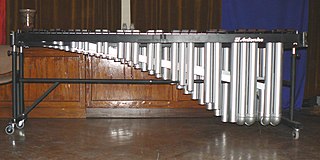
The marimba is a percussion instrument consisting of a set of wooden bars struck with yarn wrapped or rubber mallets to produce musical tones. Resonators or pipes are suspended underneath the bars to amplify the sound of the wooden bars. The bars of a chromatic marimba are arranged like the keys of a piano, with the groups of two and three accidentals raised vertically, overlapping the natural bars to aid the performer both visually and physically. This instrument is a type of idiophone, but with a more resonant and lower-pitched tessitura than the xylophone. A person who plays the marimba is called a marimbist or a marimba player.

The vibraphone is a musical instrument in the struck idiophone subfamily of the percussion family. It consists of tuned metal bars and is usually played by holding two or four soft mallets and striking the bars. A person who plays the vibraphone is called a vibraphonist,vibraharpist, or vibist.

A pipette is a laboratory tool commonly used in chemistry, biology and medicine to transport a measured volume of liquid, often as a media dispenser. Pipettes come in several designs for various purposes with differing levels of accuracy and precision, from single piece glass pipettes to more complex adjustable or electronic pipettes. Many pipette types work by creating a partial vacuum above the liquid-holding chamber and selectively releasing this vacuum to draw up and dispense liquid. Measurement accuracy varies greatly depending on the instrument.
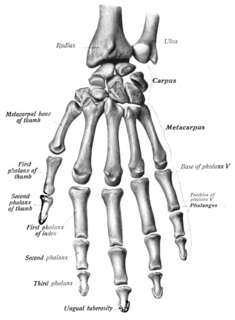
The thumb is the first digit of the hand, next to the index finger. When a person is standing in the medical anatomical position, the thumb is the outermost digit. The Medical Latin English noun for thumb is pollex, and the corresponding adjective for thumb is pollical.
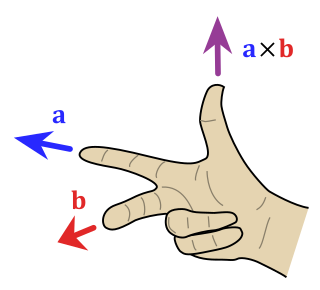
In mathematics and physics, the right-hand rule is a common mnemonic for understanding orientation of axes in three-dimensional space.

A drum roll is a technique the percussionist employs to produce, on a percussion instrument, a sustained sound, "over the value of the written note."
In the sport of cricket, a slower ball is a slower-than-usual delivery from a fast bowler. The bowler's intention is to deceive the batsman into playing too early so that he either misses the ball completely or hits it high up in the air to offer an easy catch. It is analogous to a changeup in baseball.
Leigh Howard Stevens is a marimba artist best known for developing, codifying, and promoting the Stevens technique or Musser-Stevens grip, a method of independent four-mallet marimba performance based on the Musser grip.
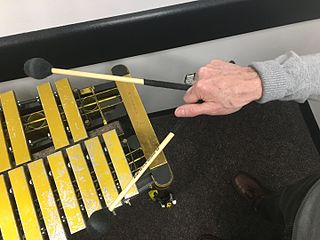
The Burton grip is a method of holding two mallets in each hand in order to play a mallet percussion instrument, such as a marimba or a vibraphone, using four mallets at once. It was developed by jazz vibraphonist Gary Burton around the 1960s.

Motion, the process of movement, is described using specific anatomical terms. Motion includes movement of organs, joints, limbs, and specific sections of the body. The terminology used describes this motion according to its direction relative to the anatomical position of the body parts involved. Anatomists and others use a unified set of terms to describe most of the movements, although other, more specialized terms are necessary for describing unique movements such as those of the hands, feet, and eyes.
The Moeller method, Moeller technique or whipping technique is a percussive stroke method that combines a variety of techniques with the goal of improving hand speed, power, and control while offering the flexibility to add accented notes at will.

In classical guitar, the right hand is developed in such a way that it can sustain two, three, and four voice harmonies while also paying special attention to tone production. The index (i), middle (m), and ring (a) fingers are generally used to play the melody, while the thumb (p) accompanies in the bass register adding harmony, and produces a comparable texture and effect to that of the piano. The classical guitar is a solo polyphonic instrument, and it is difficult to master.
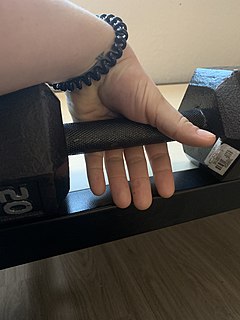
Hook grip is a method of gripping a barbell used in many strength-related sports such as Olympic weightlifting, Crossfit, and powerlifting by overlapping the index and middle finger over the thumb. This method of gripping the bar provides a secure bar grip while performing pulling motion with the barbell such as the clean and jerk, snatch, and deadlift. To perform a hook grip one must first wrap their thumb around the bar placing it parallel to the barbell and then wrap their index, and middle finger around the outside of the thumb. The pinky and ring finger typically ends up resting on the barbell. It is important to actively hooking on to the thumb with the index and middle finger while performing Hook grip compared to providing direct pressure on to the thumb.
Fulcrum is a drumming term. Traditionally, the fulcrum is said to denote the part of a percussionist's grip that is the main lever for the drumstick/mallet to rotate. This is usually created by the thumb + index finger, the thumb + middle finger, or a combination of the index, middle, and thumb.
In the sport of ten-pin bowling, there are many different ways in which to deliver the bowling ball in order to advance it toward the pins in an accurate and powerful manner. Generally, there are three basic forms of 10-pin bowling. The most basic form is known as stroking, which is the most classic form. The most powerful form is known as cranking, which imparts great leverage and maximum rotation on the ball, but sacrifices accuracy. In between the two is the domain of the tweener, who has characteristics of both, but does not truly fit into either category. A well-known variant of "tweening" is the power stroker.

Guitar picking is a group of hand and finger techniques a guitarist uses to set guitar strings in motion to produce audible notes. These techniques involve plucking, strumming, brushing, etc. Picking can be done with:

A hand is a prehensile, multi-fingered appendage located at the end of the forearm or forelimb of primates such as humans, chimpanzees, monkeys, and lemurs. A few other vertebrates such as the koala are often described as having "hands" instead of paws on their front limbs. The raccoon is usually described as having "hands" though opposable thumbs are lacking.

The golf swing is the action by which players hit the ball in the sport of golf. The golf swing is a complex motion involving the whole body; the technicalities of the swing are known as golf stroke mechanics.

In percussion, grip refers to the manner in which the player holds the percussion mallet or mallets, whether drum sticks or other mallets.
The Fulcrum grip is a four-mallet grip for vibraphone and marimba developed by vibraphonist and educator Ed Saindon. The aim of the grip is to use varying fulcrum positions and finger technique to achieve the control, speed, and power of a two-mallet grip while being able to use all four mallets.















